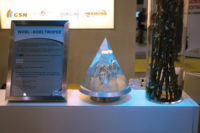With those words, Bruce Badger, president of the International Institute of Ammonia Refrigeration (IIAR), welcomed more than 1,200 attendees to the organization’s 2012 Industrial Refrigeration Conference & Exhibition. The presence of representatives from such countries as Canada, China, Colombia, France, Germany, India, Italy, Mexico, Spain, the United Kingdom, Venezuela, Thailand, and Trinidad and Tobago among others was just part of the story. In a number of instances, attendees were from industrial refrigeration trade associations in their home countries.
As noted by the outgoing IIAR chairman Adolfo Blasquez of Blasquez Refrigeration of Mexico, IIAR has a vision “to be recognized as the world’s leading advocate for the safe, reliable, and efficient use of ammonia and other natural refrigerants for industrial applications.” And that, he said, has involved developing relationships with trade associations throughout the world.
“During the past year, IIAR continued its active outreach around the world with the expansion of the affiliate membership category to include industrial refrigeration professionals living in Article 5 [developing] and BRIC [Brazil, Russia, India, and China] countries in order to make IIAR materials more accessible in the developing world.”
According to Blasquez, the process has included the following:
• Travels to China to meet with the Chinese Association of Refrigeration and to India to meet with the Association of Ammonia Refrigeration and to hold “seminars and discussions to create formal partnerships with each organization.”
• Seminars in Colombia and Ecuador with “more than 100 local end users attending.”
He noted that IIAR currently has 2,030 members. “As we expand our activity outside of North America, we expect that number to continue to grow.”
The chairman also noted representatives from the Global Cold Chain Alliance, Ammonia Safety Training Institute, Industrial Refrigeration Consortium, and the Refrigerating Engineers and Technicians Association are part of IIAR efforts to maintain ties with other trade associations.
Standards and Codes
Blasquez promoted several important IIAR achievements:
• The new standard IIAR 1 Standard, Definitions and Terminology Used in IIAR Standards.
• An updated version of IIAR 3, Ammonia Refrigeration Valves.
• Three formal standards to “guide the safe design, construction, operation, and maintenance of industrial refrigeration systems that use ammonia as a refrigerant.”
• Five other standards currently in development dealing with installation, start-up, and commissioning of closed circuit systems, maintenance and inspection, operating procedures, and de-
commissioning.
• An addendum to the Ammonia Refrigeration Piping Handbook with guidelines for developing ammonia system drawings, schematics, and diagrams.
He also noted that IIAR released “a complete update of the IIAR Process Safety Management and Risk Management Program guidelines that reflect real-life experience since the original guidelines were published about 15 years ago.”
Growth and Honors
Don Stroud of Kraft Food reported on the activities of the Ammonia Refrigeration Foundation, which he chairs. The foundation uses money raised for education programs and research projects. During the past year, according to Stroud, “The foundation sponsored a follow-on project to prove the viability of postmortem testing of relief valves to predict an appropriate replacement schedule for the valves. Testing was successfully conducted, and the standard was deemed workable and accepted by IIAR.
“The product of this research is the statistical pressure relief replacement interval calculator.”
Member of the Year honors went to Robert Czarnecki of Campbell Soup who served as chair of the IIAR Standards Committee. The Honorary Life Member award went to Jeff Welch of Welch Engineering of Ponte Vedra Beach, Fla.
In addition, IIAR hosted a free Ammonia Safety Day with more than 150 people attending including end users, emergency responders, and code officials.
Publication date: 6/18/2012









